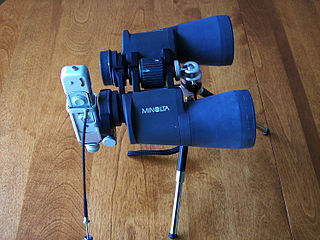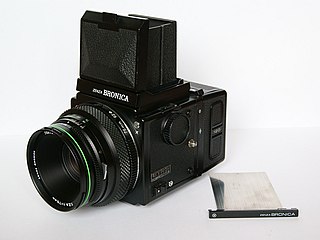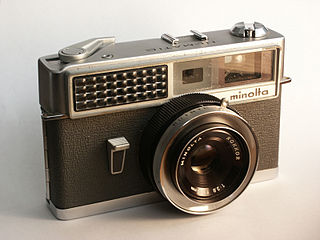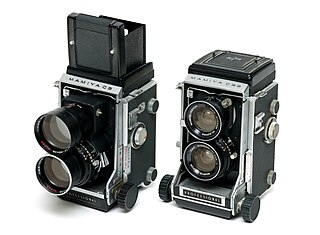
Leica Camera AG is a German company that manufactures cameras, optical lenses, photographic lenses, binoculars, and rifle scopes. The company was founded by Ernst Leitz in 1869, in Wetzlar, Germany. The name Leica is derived from the first three letters of the founder's surname (Leitz) and the first two of the word camera: lei-ca.

Minox is a manufacturer of cameras, known especially for its subminiature camera.

Zorki is the name of a series of 35mm rangefinder cameras manufactured in the Soviet Union between 1948 and 1978.

Mamiya Digital Imaging Co., Ltd. is a Japanese company that manufactures high-end cameras and other related photographic and optical equipment. With headquarters in Tokyo, it has two manufacturing plants and a workforce of over 200 people. The company was founded in May 1940 by camera designer Seiichi Mamiya and financial backer Tsunejiro Sugawara.
Kiev is a Soviet and Ukrainian brand of photographic equipment including cameras manufactured by the Arsenal Factory in Kyiv, Ukraine. The camera nameplates show the name "KIEV", with older cameras using "КИЕВ" or "КИЇВ" in Cyrillic.

Contax began as a German camera model in the Zeiss Ikon line in 1932, and later became a brand name. The early cameras were among the finest in the world, typically featuring high quality Zeiss interchangeable lenses. The final products under the Contax name were a line of 35 mm, medium format, and digital cameras engineered and manufactured by Japanese multinational Kyocera, and featuring modern Zeiss optics. In 2005, Kyocera announced that it would no longer produce Contax cameras. The rights to the brand are currently part of Carl Zeiss AG, but no Contax cameras are currently in production, and the brand is considered dormant.

The FED is a Soviet rangefinder camera, mass-produced from 1934 until around 1996, and also the name of the factory that made it.

Bronica also Zenza Bronica was a Japanese manufacturer of classic medium-format roll film cameras and photographic equipment based in Tokyo, Japan. Their single-lens reflex (SLR) system-cameras competed with Pentax, Hasselblad, Mamiya and others in the medium-format camera market.

The Canonflex is a Canon 35 mm film single-lens reflex (SLR) camera introduced in May 1959. Its standard lens is the Canon Camera Co. Super-Canomatic R 50mm lens f/1.8. The camera was in production for one year before it was replaced by the Canonflex R2000, adding a 1/2000 sec. shutter speed.

Hi-Matic was the name of a long-running series of 35 mm cameras made by Minolta. The original Hi-Matic of 1962 was the first Minolta camera to feature automatic exposure and achieved a small degree of fame when a version was taken into space by John Glenn in 1962.

Argus was an American maker of cameras and photographic products, founded in 1936 in Ann Arbor, Michigan. Argus originated as a subsidiary of the International Radio Corporation (IRC), founded by Charles Verschoor.

Retina was the brand-name of a long-running series of German-built Kodak 35mm cameras, produced from 1934 until 1969. Kodak Retina cameras were manufactured in Stuttgart-Wangen by the Kodak AG Dr. Nagel Werk which Kodak had acquired in December 1931.

The Konica Hexar RF is a 35 mm rangefinder camera which was sold by Konica. It was introduced to the market on 13 October 1999. and subsequently discontinued some time before the end of 2003. The camera used the "Bayonet Konica KM-mount", a copy of the Leica M-mount, thus sharing interchangeable lenses with those designed for Leica cameras and others compatible with them. The Hexar RF has a combined rangefinder/viewfinder modeled on that of Leica cameras, a similar body shape and size - and so is similar to Leica M-mount cameras in many aspects of operation.

The FED 2 was a 35 mm rangefinder camera introduced in 1955 by FED. The name of FED comes from the initial of Felix Edmundovich Dzerzhinsky.

The Kodak Retina Reflex is a discontinued series of four single-lens reflex cameras made by Kodak in Germany between 1957 and 1974, as part of the Kodak Retina line of 35mm film cameras.

The Kodak 35 Rangefinder is an improved version of the Kodak 35 that was launched by the Eastman Kodak Company in 1938 as their first 35mm camera manufactured in the USA. After some two years, the Company presented this improved Kodak 35 camera, with a new superstructure housing containing a viewfinder and a separate rangefinder, but without any addition to the identifying inscription on the body. It is generally referred to as the Kodak 35 Rangefinder model.

Contarex is a line of 35mm single lens reflex cameras (SLRs) made by Zeiss Ikon. It was first presented at Photokina in 1958 and initially scheduled for delivery in the spring of 1959, but it was not made generally available in the United States until March 1960. The first model is popularly known as the Contarex I, the Bullseye, or the Cyclops, after the prominent light meter window above the lens, in front of the pentaprism. The camera was aimed at the high-end and professional markets; in 1961, the retail price was $499.

The Mamiya C series is a line of twin-lens reflex medium-format system cameras manufactured by Mamiya between 1956 and 1994. It was developed from the Mamiyaflex series of cameras built from 1949 to 1956. The Mamiya C series was initially aimed at the professional market.

The Argus Museum, located on the second floor of 525 West William, Ann Arbor, Michigan, features products manufactured by the Argus camera company and tells the stories of the company, the people involved and showcases unique collections connected to Argus. The museum is housed in the Argus I Building, which was one of the facilities where Argus products were manufactured.

The Vito and Vitomatic, Vitoret, and Vito Automatic were several related lines of 35 mm compact viewfinder and rangefinder cameras made by Voigtländer from the 1940s through the early 1970s, equipped with leaf shutters, similar in concept to and marketed against the competing Kodak Retina cameras manufactured by Kodak. All of these cameras were fixed-lens models; the models in the Vito line identified with Roman numerals were equipped with folding mechanisms and collapsible lenses for portability, while the others were rigid, non-folding cameras.





















